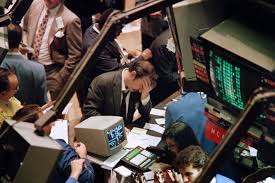Where will the next crisis occur?

INTEREST rates are heading higher and that is likely to put financial markets under strain. Investors and regulators would both dearly love to know where the next crisis will come from. What is the most likely culprit?
Financial crises tend to involve one or more of these three ingredients: excessive borrowing, concentrated bets and a mismatch between assets and liabilities. The crisis of 2008 was so serious because it involved all three—big bets on structured products linked to the housing market, and bank-balance sheets that were both overstretched and dependent on short-term funding. The Asian crisis of the late 1990s was the result of companies borrowing too much in dollars when their revenues were in local currency. The dotcom bubble had less serious consequences than either of these because the concentrated bets were in equities; debt did not play a significant part.
Get our daily newsletter
Upgrade your inbox and get our Daily Dispatch and Editor’s Picks.
It may seem surprising to assert that the genesis of the next crisis is probably lurking in corporate debt. Profits have been growing strongly. Companies in the S&P 500 index are on target for a 25% annual gain once all the results for the first quarter are published. Some companies, like Apple, are rolling in cash.
But plenty are not. In recent decades companies have sought to make their balance-sheets more “efficient” by raising debt and taking advantage of the taxdeductibility of interest payments. Businesses with spare cash have tended to use it to buy back shares, either under pressure from activist investors or because doing so will boost the share price (and thus the value of executives’ options).
At the same time, a prolonged period of low rates has made it very tempting to take on more debt. S&P Global, a credit-rating agency, says that as of 2017, 37% of global companies were highly indebted. That is five percentage points higher than the share in 2007, just before the financial crisis hit. By the same token, more private-equity deals are loading up on lots of debt than at any time since the crisis.
One sign that the credit quality of the market has been deteriorating is that, globally, the median bond’s rating has dropped steadily since 1980, from A to BBB- (see chart). The market is divided into investment grade (debt with a high credit rating) and speculative, or “junk”, bonds below that level. The dividing line is at the border between BBB- and BB+. So the median bond is now one notch above junk.
Even within investment-grade debt, quality has gone down. According to PIMCO, a fund-management group, in America 48% of such bonds are now rated BBB, up from 25% in the 1990s. Issuers are also more heavily indebted than before. In 2000 the net leverage ratio for BBB issuers was 1.7. It is now 2.9.
Investors are not demanding higher yields to compensate for the deteriorating quality of corporate debt; quite the reverse. In a recent speech during a conference at the London Business School, Alex Brazier, the director for financial stability at the Bank of England, compared the yield on corporate bonds with the risk-free rate (the market’s forecast for the path of official short-term rates). In Britain investors are demanding virtually no excess return on corporate bonds to reflect the issuer’s credit risk. In America the spread is at its lowest in 20 years. Just as low rates have encouraged companies to issue more debt, investors have been tempted to buy the bonds because of the poor returns available on cash.
Mr Brazier also found that the cost of insuring against a bond issuer failing to repay, as measured by the credit-default-swap market, fell by 40% over the past two years. That makes it seem as if investors are less worried about corporate default. But a model looking at the way that banks assess the probability of default, compiled by Credit Benchmark, a data-analytics company, suggests that the risks have barely changed over that period.
So investors are getting less reward for the same amount of risk. Combine this with the declining liquidity of the bond market (because banks have withdrawn from the market-making business) and you have the recipe for the next crisis. It may not happen this year, or even next. But there are already ominous signs.
Matt King, a strategist at Citigroup, says that foreign purchases of American corporate debt have dried up in recent months, and the return on investment-grade debt so far this year has been -3.5%. He compares the markets with a game of musical chairs. As central banks withdraw monetary stimulus, they are taking seats away. Eventually someone will miss a seat and come down with a bump.
Correction (May 2nd 2018): This article originally stated that the median bond’s rating is junk. In fact it is one notch above.






